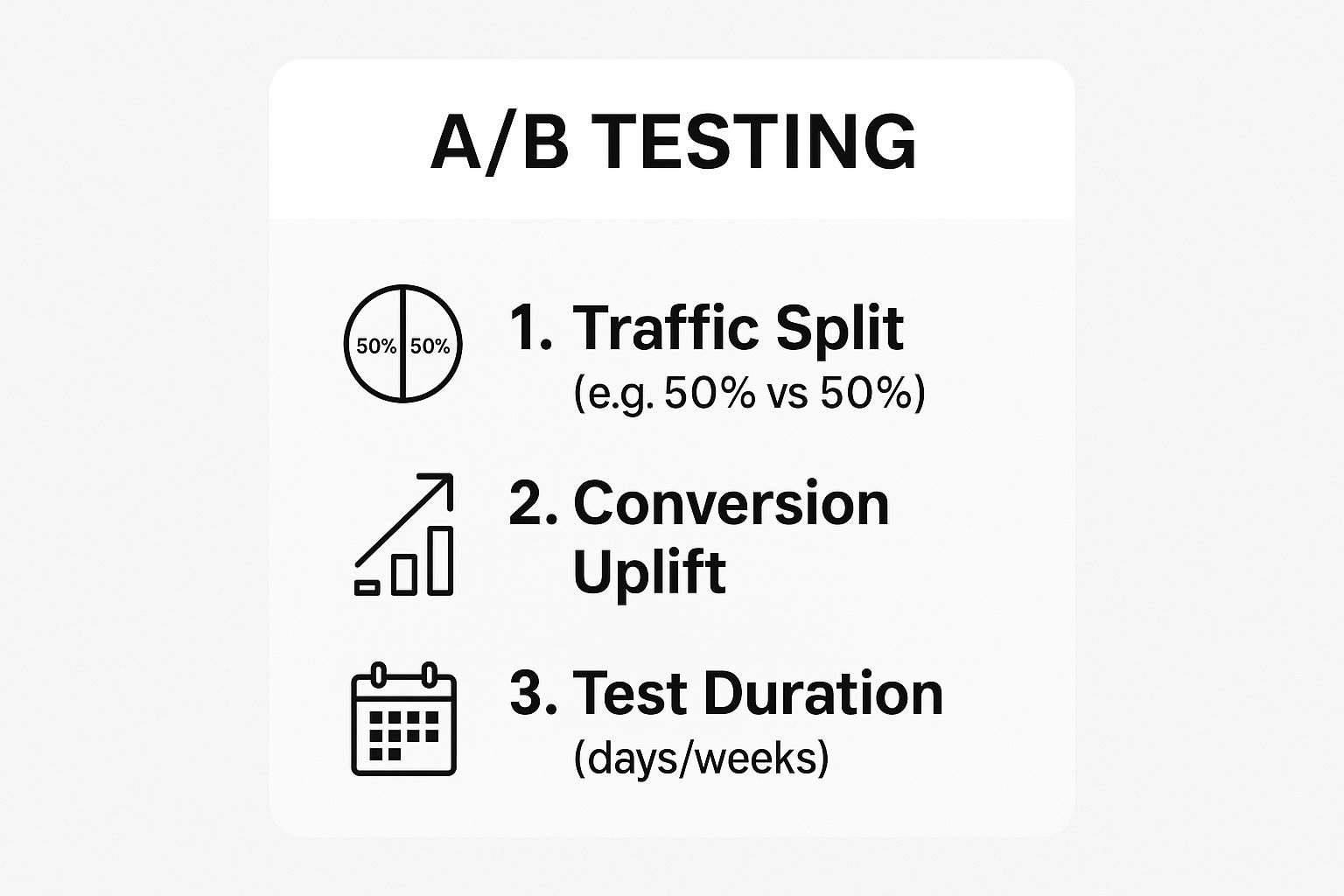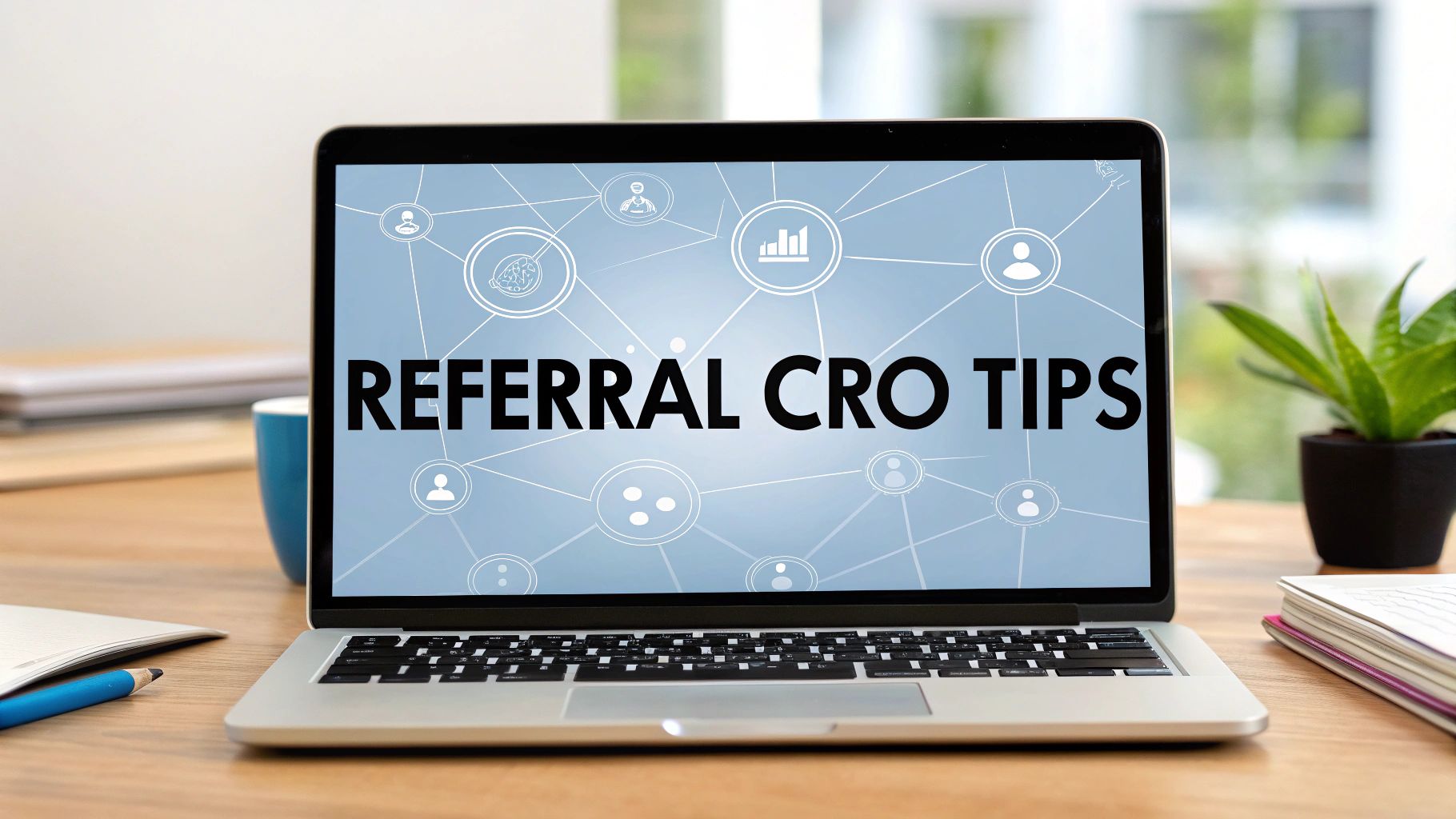In the competitive SaaS landscape, a high-performing referral or affiliate program isn't just a bonus; it's a critical growth engine. Launching a program is only the first step. The real challenge lies in transforming referred visitors and potential affiliates into active, revenue-generating partners. This requires a targeted approach to conversion rate optimization (CRO) tailored specifically for the unique dynamics of referral marketing.
Generic advice won't cut it. You need strategies that address the specific friction points in the affiliate signup funnel and the referred customer's journey. This article provides 7 advanced conversion optimization tips designed to supercharge your SaaS referral program. We'll move beyond the basics, offering actionable tactics, real-world examples, and implementation details to help you build a high-converting, self-sustaining growth loop. While our playbook focuses on referral-specific strategies, a strong foundation in general conversion optimization strategies is crucial for overall success.
From A/B testing your rewards to optimizing the mobile experience for both affiliates and their referrals, these insights will equip you to maximize every click and every signup. Whether you're an early-stage startup or a product-led growth team, these techniques will help you unlock your program's full potential.
1. A/B Testing Your Affiliate Onboarding Flow
While most SaaS companies religiously A/B test their customer-facing landing pages, many neglect an equally critical conversion funnel: their affiliate onboarding flow. This is a significant missed opportunity. Applying the same data-driven rigor to your partner program can dramatically increase both the quantity and quality of affiliates who sign up and start generating revenue.
This approach involves systematically comparing two or more versions of a single element in your affiliate journey to see which performs better. It’s one of the most effective conversion optimization tips because it replaces guesswork with hard data, ensuring every change you make is a step toward higher performance. You're not just optimizing for a single signup; you're refining the entire lifecycle from an affiliate's first impression to their first successful referral payout.
How to Implement A/B Testing for Your Program
Start by identifying the highest-impact pages in your affiliate funnel. The affiliate landing page and the signup form are the most logical starting points.
- Headlines and CTAs: Test different value propositions. For example, SaaS A could test "Join Our Partner Program" (Version A) against a more benefit-driven "Start Earning Today" (Version B). A simple change like this can often yield a double-digit lift in signups.
- Form Length: The friction of a long form can deter potential affiliates. SaaS B tested a single-field email signup against a multi-field form. While the multi-field form gathered more data upfront, the single-field version increased top-of-funnel signups by 40%, allowing them to nurture leads into active partners later.
- Commission Structures: Test different reward models to see which attracts the best partners. You could pit a 20% recurring commission against a larger 30% first-year-only commission to determine which model your ideal affiliates prefer.
This infographic breaks down the essential components of a well-structured A/B test.

As the visual highlights, a successful test requires an even traffic split, a clear measurement of the conversion uplift, and an adequate duration to ensure statistical significance.
Why This Method Works
A/B testing provides clear, quantitative evidence of what resonates with your potential partners. By isolating variables and measuring outcomes, you create a feedback loop that continuously improves your program's efficiency. For deeper insights into establishing a testing culture, this video from the experts at ConversionXL offers a foundational overview.
2. Landing Page Optimization
Landing page optimization is the process of methodically enhancing every element of the page where potential affiliates ‘land’ after clicking an ad or link. The objective is to increase the percentage of visitors who sign up for your partner program. For SaaS companies, a well-optimized affiliate landing page is not just a marketing asset; it's a powerful engine for partner acquisition and one of the most fundamental conversion optimization tips you can implement.
This practice moves beyond simple aesthetics to focus on the psychology of the user journey, ensuring that your messaging, design, and user experience work in harmony to drive a single, desired action: signing up. From the headline they first read to the button they last click, every component is refined for maximum impact.

How to Implement Landing Page Optimization
Effective optimization starts with understanding your audience and removing friction from their path to conversion. Focus on clarity, trust, and a seamless user experience.
- Maintain Message Match: The headline and core message of your landing page must directly reflect the promise made in the ad or link the visitor clicked. If your social media post promises a "30% Recurring Commission," that exact phrase should be prominent on the landing page to create a coherent and trustworthy experience.
- Simplify Your Forms: Every field you ask a potential partner to fill out is a point of friction. Start with the absolute minimum information required, such as an email address. Dropbox famously used a simple landing page with a video and a straightforward call-to-action to grow exponentially. You can always gather more details after the initial sign-up.
- Incorporate Social Proof: Display testimonials, logos of well-known partners, or statistics like "Over 1,000 partners trust us." This builds immediate credibility and reassures visitors they are joining a legitimate and successful program.
- Optimize for Mobile: A significant portion of your potential affiliates will discover your program on a mobile device. Ensure your landing page is fully responsive, with large, easy-to-tap buttons and readable text, to avoid losing valuable signups due to a poor mobile experience.
Why This Method Works
Landing page optimization works because it is a user-centric approach grounded in data. Instead of guessing what might appeal to potential partners, you systematically refine your page based on user behavior and feedback. This creates a direct and compelling path to conversion, ensuring that the traffic you drive to your affiliate page has the highest possible chance of converting into an active partner. For more ideas on how to integrate this into your broader growth efforts, explore this guide to developing a powerful startup marketing strategy on Refgrow.com.
3. Call-to-Action (CTA) Optimization
Your call-to-action (CTA) is the tipping point where a potential affiliate or customer decides to act. Optimizing this single element, from the text on a button to its color and placement, can yield some of the most dramatic improvements in your conversion rates. It’s one of the most powerful conversion optimization tips because it directly targets the final moment of decision-making in your user's journey.
CTA optimization involves methodically testing and refining the prompts that guide users toward your desired goal, whether that's signing up for a partner program or starting a free trial. By focusing on these critical touchpoints, you remove friction and ambiguity, making it easier for users to say "yes." This process transforms your CTA from a simple button into a finely tuned conversion engine.
How to Implement CTA Optimization
The key is to test one change at a time to isolate what truly drives action. Start with your most important pages, like your affiliate landing page or pricing page, and focus on the primary CTA.
- Language and Phrasing: The words you use matter immensely. Performable famously increased conversions by 21% simply by changing button text from "Start your free 30-day trial" to "Start my free 30-day trial." This first-person perspective creates a sense of ownership.
- Color and Contrast: Your button needs to stand out. While there's no single "best" color, contrast is crucial. ContentVerve saw a 90% conversion lift by changing a button from green to red, not because red is inherently better, but because it contrasted more sharply with their page design.
- Placement and Size: Ensure your CTA is visible and easy to click, especially on mobile devices. Position it above the fold where users can see it without scrolling, and repeat it after key sections of your page to catch users at their moment of highest intent.
Why This Method Works
Effective CTA optimization works because it leverages human psychology. Using urgent language like "Get Started Now" creates a sense of immediacy, while personalized CTAs make the user feel understood. HubSpot found that personalized CTAs convert an incredible 202% better than generic, default versions.
By systematically refining these small but crucial details, you make the desired action feel like the most natural and logical next step for the user. This data-driven approach removes guesswork and builds a high-performance conversion path one click at a time. For more in-depth guidance on crafting compelling CTAs, the experts at HubSpot offer comprehensive resources.
4. Social Proof Integration
Integrating social proof involves strategically placing testimonials, user counts, and expert endorsements throughout your partner program assets to build trust and credibility. This psychological principle, popularized by Dr. Robert Cialdini, leverages our natural tendency to follow the actions of others when uncertain. For a potential affiliate weighing your program against competitors, seeing that others have already succeeded can be the decisive factor that encourages them to sign up.
This isn't just about plastering logos on a page; it’s one of the most powerful conversion optimization tips because it directly addresses a core human need for validation. When a prospective partner sees evidence that others trust and benefit from your program, it lowers their perceived risk and validates their decision to join. You're effectively borrowing credibility from your existing successful partners to attract new ones.
How to Implement Social Proof for Your Program
Begin by identifying the most impactful points in your affiliate journey to add validation. The landing page, signup confirmation page, and onboarding emails are prime locations.
- Display User and Partner Counts: Numbers create a powerful impression of scale and success. For example, a SaaS company could state, "Over 500+ partners are earning with us." This immediately establishes the program as a popular and legitimate opportunity, much like Basecamp does by displaying its impressive customer count.
- Showcase High-Quality Testimonials: Vague praise like "great program" is forgettable. Instead, use specific, benefit-driven testimonials. A testimonial saying, "I earned my first $1,000 commission in just 45 days" is far more compelling. For maximum authenticity, include the affiliate's full name, photo, and a link to their business.
- Leverage Brand Logos: If well-known companies or influencers are part of your affiliate program, display their logos prominently. This "endorsement by association" was a key growth lever for Slack, which used testimonials from recognizable brands to establish credibility in its early days.
Why This Method Works
Social proof works by providing tangible evidence that your program delivers on its promises, transforming abstract claims into concrete results. It builds an immediate sense of trust and community, making potential partners feel more confident in their choice. By showing that other, similar individuals have succeeded, you make the path to success seem achievable and appealing.
This strategy is foundational to building a scalable program, as successful partners become your most effective marketing asset. To learn how to leverage these enthusiastic advocates, you can boost business success with customer referral programs on refgrow.com.
5. Form Optimization
The affiliate signup form is the final barrier between a prospective partner and your program. Even the most compelling offer can be undone by a clunky, demanding, or confusing form. Form optimization is the art and science of streamlining this crucial step to maximize completions and minimize abandonment, turning interested visitors into registered, active affiliates.
This is one of the most direct conversion optimization tips you can implement because it targets a high-intent moment in the user journey. Every field you remove, every label you clarify, and every error message you improve contributes directly to a better user experience and a higher signup rate. It’s about making it as easy as possible for someone to say "yes" to your program.
How to Implement Form Optimization for Your Program
Start by auditing your current affiliate signup form. Ask yourself if every single field is essential for the initial registration. Often, you can collect additional information later in the onboarding process.
- Reduce Field Count: Does your initial form need a full address, company name, and phone number? Expedia famously increased profits by $12 million simply by removing one optional field ("Company Name") from their booking form. Apply the same minimalist principle to your affiliate signup.
- Improve Layout and Flow: Single-column layouts are generally easier for users to scan and complete than multi-column designs. Group related fields together, such as "Payment Information," to create a logical flow that doesn't feel overwhelming.
- Implement Smart Defaults and Validation: Use clear, inline validation to provide immediate feedback, rather than waiting until the user clicks "Submit." For mobile users, ensure you're using the correct input types (e.g.,
type="email",type="tel") to bring up the appropriate keyboard. - Test Multi-Step Forms: For longer forms, breaking them into multiple, smaller steps can reduce psychological friction. Design agency Imaginary Landscape saw a 120% conversion lift by replacing a long form with a multi-step process. This approach can make the signup feel less intimidating and more manageable.
Why This Method Works
Form optimization works because it directly addresses and removes user friction at the point of conversion. By asking for less and guiding the user more effectively, you lower the cognitive load required to sign up. This creates a smoother, faster, and more positive first impression of your program, setting the stage for a successful partnership.
This principle of reducing friction is a core tenet of effective user onboarding. To see how these ideas extend beyond the initial signup, you can explore more insights into creating a seamless journey for new users. For more information, discover these SaaS onboarding best practices on refgrow.com.
6. Page Load Speed Optimization
In the world of affiliate and referral programs, every second counts. Page load speed optimization is the technical practice of reducing the time it takes for your affiliate landing pages, signup forms, and dashboards to fully load. This is one of the most fundamental conversion optimization tips because a slow-loading page is a conversion killer. A frustrating user experience leads to high bounce rates, meaning potential partners leave before they even see your offer.

The impact of speed is well-documented and staggering. For instance, Walmart found that for every one-second improvement in load time, conversions increased by 2%. Similarly, the BBC discovered they lost an additional 10% of users for every extra second their site took to load. When a potential affiliate clicks your link, you have a tiny window to capture their interest; a lagging site wastes that opportunity.
How to Implement Page Speed Optimization
Improving your page speed involves a multi-faceted approach, targeting both front-end and back-end elements. Start by running your affiliate pages through a tool like Google's PageSpeed Insights to get a baseline score and specific recommendations.
- Compress and Optimize Images: Large, uncompressed images are often the biggest culprits. Use tools like TinyPNG or ImageOptim to drastically reduce file sizes without sacrificing quality before uploading them to your affiliate landing page.
- Enable Browser Caching: Configure your server to tell browsers to store static resources like logos, CSS, and JavaScript files locally. This means returning visitors and partners will experience near-instant load times on subsequent visits.
- Use a Content Delivery Network (CDN): A CDN like Cloudflare stores copies of your site on servers around the globe. It serves your content from the location closest to the user, dramatically reducing latency for your international affiliate base.
- Minify Code: Minification removes unnecessary characters from your HTML, CSS, and JavaScript files, such as whitespace and comments. This reduces the file size and speeds up parsing and execution by the browser.
Why This Method Works
A faster page directly correlates with a better user experience, which builds trust and reduces friction in the conversion funnel. When your affiliate portal is snappy and responsive, it signals professionalism and reliability, encouraging partners to sign up and engage with your program. Every millisecond you shave off your load time is a direct investment in acquiring and retaining high-value partners.
7. Mobile Optimization
In an era where potential affiliates and customers discover and interact with brands primarily through their smartphones, neglecting mobile optimization is akin to closing your doors to over half your audience. Mobile optimization is the practice of ensuring your entire affiliate journey, from the partner landing page to the referral tracking dashboard, is designed for a seamless experience on smaller screens. This isn't just about making things smaller; it's about rethinking the entire user flow for touch-based interaction and on-the-go access.
For referral and affiliate programs, this is one of the most fundamental conversion optimization tips you can implement. Partners often share links and check their progress while away from a desk. If your signup form is clunky, your dashboard is unreadable on a phone, or a referred customer can't complete a purchase on their mobile device, you're leaving a significant amount of revenue on the table. A mobile-first approach ensures every touchpoint is frictionless, maximizing signups and successful referrals.
How to Implement Mobile Optimization for Your Program
Start by adopting a responsive design framework, which allows your web pages to adapt gracefully to any screen size. From there, focus on the specific user experience elements critical to mobile users.
- Simplify Navigation and Forms: Mobile users have less patience for complex processes. Shorten your affiliate signup form to only the most essential fields. Use collapsible menus and a clear information hierarchy so partners can find what they need without excessive pinching and zooming.
- Design for Touch: Ensure all buttons, links, and interactive elements are large enough for easy tapping. A common best practice is to make tap targets at least 44x44 pixels. This prevents frustrating mis-clicks and improves usability.
- Optimize for Speed: Mobile connections can be less reliable than broadband. Compress images, minify code (CSS, JavaScript), and leverage browser caching to ensure your pages load almost instantly. A slow-loading partner page is a primary cause of high bounce rates. For example, AutoAnything increased mobile conversions by 51% simply by focusing on mobile-specific design improvements and faster load times.
Why This Method Works
Mobile optimization works because it meets your users where they are. By removing barriers specific to mobile devices, you create a more accessible and user-friendly experience that directly translates to higher engagement and conversion rates. It acknowledges that the affiliate and customer journeys are no longer confined to the desktop. Building a program that is as powerful on a smartphone as it is on a laptop ensures you capture every possible opportunity for growth, regardless of the device being used.
7 Conversion Optimization Tips Comparison
| Item | Implementation Complexity 🔄 | Resource Requirements ⚡ | Expected Outcomes 📊 | Ideal Use Cases 💡 | Key Advantages ⭐ |
|---|---|---|---|---|---|
| A/B Testing | Moderate to high; requires traffic and setup | Medium; tools needed + traffic volume | Data-driven decisions with measurable conversion uplift | Testing specific webpage elements or variants | Concrete data, reduces guesswork, culture of testing |
| Landing Page Optimization | Medium; design & content iteration | Medium to high; design, copywriting, testing | Improved conversions, better ROI on ads | Pages targeted from ads, emails to boost conversions | Focused UX, measurable impact, lowers acquisition cost |
| CTA Optimization | Low to medium; quick tests on buttons/links | Low; mostly design and minor coding | Immediate conversion improvements | Buttons, links needing conversion boost | Simple, cost-effective, fast impact |
| Social Proof Integration | Low to medium; content gathering & placement | Low to medium; content creation and updates | Builds trust, higher conversions | Websites needing trust building and credibility | Builds credibility, low cost, psychological leverage |
| Form Optimization | Medium; UX design and technical validation | Medium; development + UX design | Higher form completion, better data quality | Lead capture, sign-up, checkout processes | Reduced abandonment, improved user experience |
| Page Load Speed Optimization | High; technical and continuous monitoring | High; developer time, tools, infrastructure | Better UX, SEO, and conversions | All websites needing performance and UX improvement | Improves SEO, reduces bounce, faster sites |
| Mobile Optimization | High; responsive & mobile-specific design | High; design, development, testing | Increased mobile traffic conversions and engagement | Websites with significant mobile visitors | Captures mobile users, boosts mobile conversions |
From Clicks to Conversions: Activating Your Growth Flywheel
The journey from a simple click to a committed conversion is paved with intentional design, relentless testing, and a deep understanding of user psychology. The strategies we've explored are not just a checklist of tasks; they are a fundamental mindset shift. Viewing your SaaS referral and affiliate programs through the lens of continuous improvement transforms them from a static channel into a dynamic, self-propelling growth flywheel.
Mastering these conversion optimization tips is about more than just incremental gains. It's about systematically dismantling every barrier, no matter how small, that stands between your advocates and their success, and between their audience and your product. Each optimized element builds on the last, creating a compounding effect that accelerates growth and deepens partner loyalty.
Synthesizing Your Action Plan
To move from theory to execution, let's distill the core principles into actionable takeaways:
- Embrace Data-Driven Decisions: Stop guessing what works. Implement rigorous A/B testing on your landing pages, CTAs, and forms to let user behavior guide your strategy.
- Prioritize the User Experience (UX): Every interaction matters. From lightning-fast page load speeds and seamless mobile optimization to intuitive form fields, a frictionless experience is a high-converting one.
- Build Trust Instantly: Leverage the power of social proof. Testimonials, case studies, and partner logos aren't just decorative elements; they are crucial trust signals that validate the decision to convert.
The most critical takeaway is that conversion optimization is not a one-time project but an ongoing process of refinement. Start small. Identify the single biggest point of friction in your current referral funnel. Is it a confusing landing page? An overly long signup form? A weak call-to-action? Apply one of the specific tactics from this guide to that single problem area, measure the results, and then move to the next.
This iterative approach ensures you make meaningful progress without becoming overwhelmed. For a foundational understanding of the core principles that drive customer action, delve into an article on how to boost sales through learning What Is Conversion Rate Optimisation. By committing to this cycle of testing, learning, and implementing, you are not just boosting numbers; you are building a more efficient, profitable, and partner-friendly growth engine that will serve your SaaS for years to come.
Ready to build a referral program with conversion optimization at its core? Refgrow provides natively embeddable components designed to create a seamless, high-trust experience for both your partners and their referrals. Stop wrestling with clunky portals and start converting with Refgrow.

